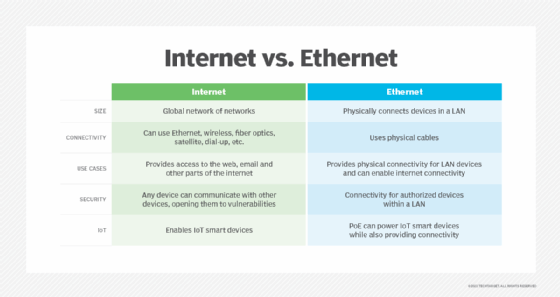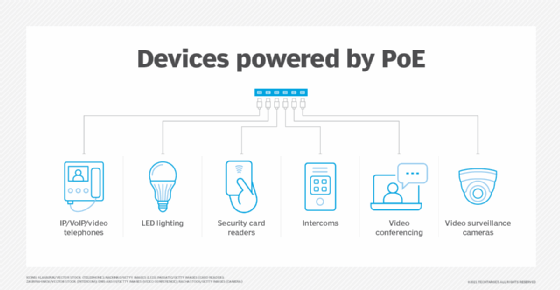
Getty Images/iStockphoto
What's the difference between internet and Ethernet?
Internet and Ethernet both enable connectivity and communication, but they differ in scope, purpose, reliability and medium. Use this guide to learn about the concepts.
Internet and Ethernet are two forms of connectivity that both enable communication between users and devices. Although their names sound similar and they both share a goal of providing network access, their respective methods and forms of connectivity differ considerably.
The internet is an interconnected network that connects users from all over the world in a single massive system. Devices on the internet can talk to one another within the global infrastructure. Ethernet connects devices in a local area network (LAN), which is a much smaller collection of interconnected devices. Devices can use Ethernet to connect within their LAN and also to the internet.
This article discusses the major differences between the internet and Ethernet, their use cases and connectivity methods.
Differences between internet vs. Ethernet
The internet and Ethernet share several similarities as technologies that enable communication, but they differ considerably. Some main distinctions between the two are the following:
- Size. The internet is a global area network (GAN) that connects millions of users and devices worldwide. Ethernet connects devices together in a LAN.
- Connectivity. Internet service providers (ISPs) provide wired connectivity through various methods, such as fiber optics and coaxial cables, or wireless connectivity with satellite. Ethernet uses wired connections, such as Cat5 or Cat6 twisted-pair cables, to connect devices.
- Reliability. Internet reliability depends on the strength of the user's LAN connection and the ISP's infrastructure. An Ethernet network is typically more reliable due to its wired connection and more controlled environment.
- Security. The internet can pose security threats because it connects millions of devices around the world, which increases user exposure to bad actors. Internet security depends on the protective measures put in place by users and ISPs. Ethernet provides a more secure connection because it uses physical cables to link devices in a LAN, making it harder for attackers to infiltrate.
- Performance. Internet performance depends on LAN performance and ISP offerings, but speeds typically range from 50 Mbps to more than 1 Gbps. Ethernet connections provide faster speeds of up to 100 Gbps in enterprise environments and are better suited for bandwidth-heavy use cases, such as the data transfer of large files or video streaming.
- Use cases. Internet use cases include communication, web browsing, file transfers, cloud services and online gaming. Ethernet use cases include device interconnection, backbone connectivity within data centers, gaming, video surveillance and home networks.
What is the internet?
The internet is a GAN that comprises thousands of networks and users worldwide. It wasn't always this expansive, though. Government researchers created the internet's predecessor, Advanced Research Projects Agency Network, or ARPANET, in the 1960s to share data and information with each other across the network. Only computers on the same network could communicate with each other through packet switching.
It wasn't until the early 1980s that a team of engineers created a way for computers located on different networks to communicate with each other via TCP/IP. TCP/IP was the catalyst that prompted the internet to grow into the resource it has become. Without TCP/IP and other protocols that emerged, devices located across separate networks aren't able to communicate with each other.
Since its inception, the internet has taken the world by storm. Tens of thousands of smaller networks operated and managed by organizations exist on the internet. Users connect to the internet with various hardware appliances that communicate through protocols.
The internet is the world's largest GAN, with billions of devices using it worldwide. Over 67% of the world's population has access to the internet as of October 2024, per Statista. The World Wide Web is the most used internet service. The web is another term used interchangeably with the internet, but the two aren't the same. The web is only one service of the overall internet infrastructure and is generally used as a collection of information and resources. Other services include email and FTP.
Internet vs. Wi-Fi
The term Wi-Fi is also commonly misconstrued with internet, but they're separate concepts. The internet is a worldwide network of interconnected users and devices. Wi-Fi is a form of wireless networking technology that uses radio waves to communicate between devices on a local network. Wi-Fi connects devices to routers, which can provide access to the internet and other resources on the LAN.
The type of Wi-Fi network depends on the IEEE 802.11 protocol standard. Different versions of Wi-Fi, such as Wi-Fi 6 or Wi-Fi 7, use updated sets of protocol standards -- 802.11ax and 802.11be, respectively. These standards determine the security, reliability and speed of the local Wi-Fi network, which affects how efficiently the internet connection works within the network.
Internet use cases
Use cases for the internet include the following:
- Communication through emails and IM.
- File transfer between devices.
- Web browsing.
- IoT infrastructure support.
- Access to cloud services.
- Online gaming and streaming.

What is Ethernet?
Ethernet is a set of standards that connects devices together in a LAN. A physical Ethernet cable connects the devices and facilitates communication between them. Data travels across the wires in the form of electrical signals or light pulses. Ethernet protocols define the rules for data transmission and enable the devices to talk to each other.
Ethernet developed around the same time as the internet. Researchers created Ethernet in the mid-1970s to link multiple computers together in a single LAN. LANs had been in use since the 1960s, but Ethernet was the first technology to successfully link computers together within one.
In 1983, IEEE approved the first official Ethernet standard -- only 10 Mbps at the time. Current Ethernet capability can now support up to 400 Gbps with the use of the 400 Gigabit Ethernet standard. IEEE is currently developing 800 GbE and 1.6 Terabit Ethernet standards for high-performance computing, AI and machine learning environments.
Because Ethernet cables are physically connected to hardware devices, an Ethernet connection offers less risk and more reliability compared to a wireless connection. Internet speeds are also much faster with Ethernet. However, because Ethernet uses a wired connection, it has a limited range in distance, typically from 30 meters to 100 meters. Environments with high-bandwidth services that require secure, high-speed internet access, such as universities, company offices and hospitals, typically use Ethernet.
Ethernet use cases
Use cases for Ethernet include the following:
- Device connection within a LAN.
- Data center backbone connectivity.
- Gaming and video streaming.
- Video surveillance.
- Power over Ethernet (PoE) support for IoT devices.
How to connect to the internet
An appliance called a modem enables internet connectivity from ISPs, such as AT&T and Verizon. A router enables devices on a network to use that internet connection simultaneously. Some appliances combine both modem and router functionality.
Devices can connect to a router via wired or wireless connections. For example, Wi-Fi and cellular connectivity, such as 4G and 5G, are common wireless ways to connect devices to the internet. Wired methods include Ethernet and fiber optic cables. Other connectivity methods include satellite, dial-up and DSL.
As wireless and mobile devices have become more commonplace, Wi-Fi, 4G and 5G have grown as popular connectivity methods. But Ethernet can provide many benefits over Wi-Fi, as it provides reliable, high-speed connectivity for online gaming, home offices, and other high-bandwidth or latency-sensitive environments.
IoT
IoT describes the system of billions of devices connected to the internet. These devices, or things, have the capability to transfer and share data over the internet. Colloquially dubbed as smart devices, these devices can autonomously communicate with each other without human involvement.
IoT has simplified processes for both consumers and businesses. Users who install smart objects in their homes can control them with their smartphones, effectively turning their home into a smart home. Businesses can also automate processes and reduce human labor with IoT devices.
Power over Ethernet
PoE is a type of Ethernet technology that enables Ethernet cables to carry both data and electrical power to connected devices. This eliminates the need for separate power cables and simplifies device installation. PoE is designed to safely deliver power alongside data on the same cable, offering a more streamlined approach to traditional power wiring.
Although traditional Ethernet cables are specifically for wired devices, network teams can deploy PoE to power wireless IoT devices. PoE for IoT is preferable for network teams looking to save costs and simplify the configuration process. Additionally, PoE delivers the same speed, security and reliability as traditional Ethernet cables.

Editor's note: This article was updated to improve the reader experience.
Deanna Darah is site editor for Informa TechTarget's Networking site. She began editing and writing at TechTarget after graduating from the University of Massachusetts Lowell in 2021.








